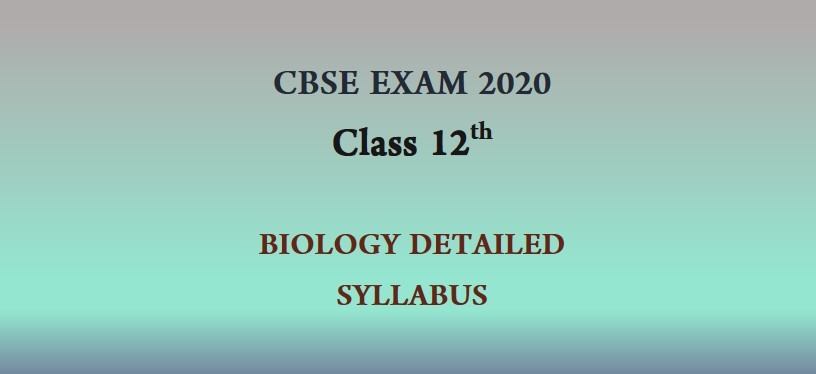
Here in this article the students can find the detailed CBSE Class 12 Biology Syllabus 2019-20. Each chapter is described topic wise. Students should follow this and prepare according to it for the exams.
DOWNLOAD eSaral APP for JEE & NEET Preparation. Get Free video lectures, tests, practice questions designed by Top IITian Faculties of Kota.
|
UNIT |
TOPICS |
| Chapter-1 | The Living World · What is living? Biodiversity · Need for classification; three domains of life; taxonomy and systematics; concept of species and taxonomical hierarchy; binomial nomenclature; tools for study of taxonomy- museums, zoological parks, herbaria, botanical gardens |
| Chapter-2 | Sexual Reproduction in Flowering Plants · Flower structure; development of male and female gametophytes; pollination - types, agencies and examples; outbreeding devices; pollen-pistil interaction; double fertilization, post fertilization events - development of endosperm and embryo, development of seed and formation of fruit; special modes- apomixis, parthenocarpy, polyembryony; Significance of seed dispersal and fruit formation |
| Chapter-3 | Human Reproduction · Male and female reproductive systems; microscopic anatomy of testis and ovary; gametogenesis - spermatogenesis and oogenesis; menstrual cycle ; fertilisation, embryo development upto blastocyst formation, implantation; pregnancy and placenta formation (elementary idea); parturition (elementary idea); lactation (elementary idea) |
| Chapter-4 | Reproductive Health · Need for reproductive health and prevention of Sexually Transmitted Diseases (STDs); birth control - need and methods, contraception and medical termination of pregnancy (MTP), amniocentesis; infertility and assisted reproductive technologies - IVF, ZIFT, GIFT (elementary idea for general awareness) |
| Chapter-5 | Principles of Inheritance and Variation · Heredity and variation: Mendelian inheritance; deviations from Mendelism – incomplete dominance, co- dominance, multiple alleles and inheritance of blood groups, pleiotropy · elementary idea of polygenic inheritance; chromosome theory of inheritance; chromosomes and genes; Sex determination- in humans, birds and honey bee; linkage and crossing over; sex linked inheritance - haemophilia, colour blindness · Mendelian disorders in humans -thalassemia; chromosomal disorders in humans · Down's syndrome · Turner's and Klinefelter's syndromes |
| Chapter-6 | Molecular Basis of Inheritance · Search for genetic material and DNA as genetic materia · Structure of DNA and RNA; DNA packaging · DNA replication; Central dogma; transcription, genetic code, translation; gene expression and regulation- lac operon; genome and human and rice genome projects · DNA fingerprinting |
| Chapter-7 | Evolution · Origin of life; biological evolution and evidences for biological evolution (paleontology, comparative anatomy, embryology and molecular evidences) · Darwin's contribution, modern synthetic theory of evolution; mechanism of evolution - variation (mutation and recombination) and natural selection with examples, types of natural selection; Gene flow and genetic drift · Hardy - Weinberg's principle; adaptive radiation; human evolution |
| Chapter-8 | Human Health and Diseases ·Pathogens; parasites causing human diseases (malaria, dengue, chickengunia, filariasis, ascariasis, typhoid, pneumonia, common cold, amoebiasis, ring worm) and their control · Basic concepts of immunology - vaccines; cancer, HIV and AIDS; Adolescence - drug and alcohol abuse |
| Chapter-9 | Strategies for Enhancement in Food Production · Improvement in food production · Plant breeding, tissue culture, single cell protein · Biofortification · Apiculture and Animal husbandry |
| Chapter-10 | Microbes in Human Welfare · In household food processing, industrial production, sewage treatment, energy generation and microbes as bio-control agents and bio-fertilizers · Antibiotics; production and judicious use |
| Chapter-11 | Biotechnology - Principles and processes · Genetic Engineering (Recombinant DNA Technology). |
| Chapter-12 | Biotechnology and its Application · Application of biotechnology in health and agriculture Human insulin and vaccine production, stem cell technology, gene therapy; genetically modified organisms - Bt crops; transgenic animals; biosafety issues, bio piracy and patents |
| Chapter-13 | Organisms and Populations · Organisms and environment: Habitat and niche, population and ecological adaptations; population interactions - mutualism, competition, predation, parasitism; population attributes - growth, birth rate and death rate, age distribution. |
| Chapter-14 | Ecosystem · Ecosystems: Patterns, components; productivity and decomposition; energy flow; pyramids of number, biomass, energy; nutrient cycles (carbon and phosphorous); ecological succession; ecological services - carbon fixation, pollination, seed dispersal, oxygen release (in brief) |
| Chapter-15 | Biodiversity and its Conservation · Biodiversity-Concept, patterns, importance; loss of biodiversity; biodiversity conservation; hotspots, endangered organisms, extinction · Red Data Book, biosphere reserves, national parks, sanctuaries and Ramsar sites |
| Chapter-16 | Environmental Issues · Air pollution and its control; water pollution and its control; agrochemicals and their effects; solid waste management; radioactive waste management; greenhouse effect and climate change impact and mitigation; ozone layer depletion; deforestation; any one case study as success story addressing environmental issue(s) |
Class 12 PHYSICS Complete Notes
Class 12 CHEMISTRY Complete Notes
Class 12 MATHEMATICS Complete Notes
